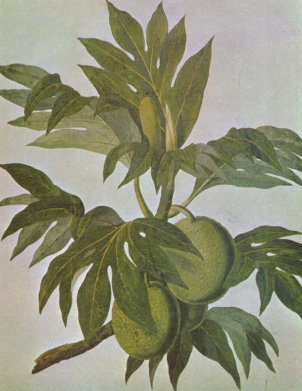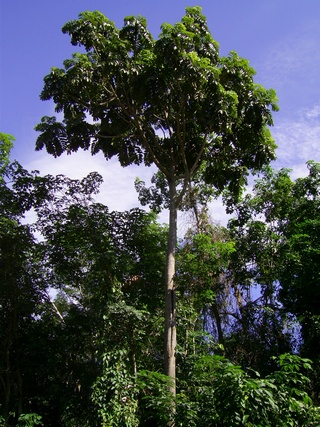
Breadfruit is a species of flowering tree in the mulberry and jackfruit family (Moraceae) believed to be a domesticated descendant of Artocarpus camansi originating in New Guinea, the Maluku Islands, and the Philippines. It was initially spread to Oceania via the Austronesian expansion. It was further spread to other tropical regions of the world during the Colonial Era. British and French navigators introduced a few Polynesian seedless varieties to Caribbean islands during the late 18th century. Today it is grown in some 90 countries throughout South and Southeast Asia, the Pacific Ocean, the Caribbean, Central America and Africa. Its name is derived from the texture of the moderately ripe fruit when cooked, similar to freshly baked bread and having a potato-like flavor.

The Moraceae—often called the mulberry family or fig family—are a family of flowering plants comprising about 38 genera and over 1100 species. Most are widespread in tropical and subtropical regions, less so in temperate climates; however, their distribution is cosmopolitan overall. The only synapomorphy within the Moraceae is presence of laticifers and milky sap in all parenchymatous tissues, but generally useful field characters include two carpels sometimes with one reduced, compound inconspicuous flowers, and compound fruits. The family includes well-known plants such as the fig, banyan, breadfruit, jackfruit, mulberry, and Osage orange. The 'flowers' of Moraceae are often pseudanthia.

Artocarpus integer, commonly known as chempedak or cempedak, is a species of tree in the family Moraceae, in the same genus as breadfruit and jackfruit. It is native to Southeast Asia. Cempedak is an important crop in Malaysia and is also popularly cultivated in southern Thailand and parts of Indonesia, and has the potential to be utilized in other areas. It is currently limited in range to Southeast Asia, with some trees in Australia and Hawaii.

Artocarpus is a genus of approximately 60 trees and shrubs of Southeast Asian and Pacific origin, belonging to the mulberry family, Moraceae. Most species of Artocarpus are restricted to Southeast Asia; a few cultivated species are more widely distributed, especially A. altilis (breadfruit) and A. heterophyllus (jackfruit), which are cultivated throughout the tropics.

Artocarpus odoratissimus is a species of flowering plant in the Moraceae family. It is a commonly called marang, madang, timadang, terap, tarap, kiran, green pedalai, or johey oak. It is native to Borneo, Palawan, and Mindanao Island, and is closely related to the jackfruit, cempedak, and breadfruit trees which all belong to the same genus, Artocarpus.
Artocarpus blancoi is a species of large tree in the family Moraceae endemic to the Philippines. Its habitat is threatened.
Artocarpus rubrovenia is a species of plant in the family Moraceae. It is endemic to the Philippines. It is threatened by habitat loss. The species was first described in 1904.
Artocarpus treculianus is a species of plant in the family Moraceae. It is endemic to the Philippines. It is threatened by habitat loss. Local names include chipuho and tipuho.

Artocarpeae is a tribe within the plant family Moraceae. It includes 7 to 12 genera and 70 to 87 species including Artocarpus altilis, the breadfruit.

Dihydromorin is a flavanonol, a type of flavonoid. It can be found in plants of the family Moraceae including Morus nigra, in Morus alba, Maclura pomifera, in the jackfruit and in Artocarpus dadah.

Artocarpus hirsutus, commonly known as wild jack, is a tropical evergreen tree species that is native to India, primarily in Kerala, but also in Karnataka, Maharashtra and Tamil Nadu, where it grows in moist, deciduous to partially evergreen woodlands.

Artocarpus anisophyllus, the entawak or mentawa, is a tropical tree in the Moraceae. It is native to the central parts of Southeast Asia, and is present in Peninsular Malaysia, Sumatra, Borneo and the intervening islands. It is called popwan in Palawan, Philippines.

Artocarpus lacucha, also known as monkey jack or monkey fruit, is a tropical evergreen tree species of the family Moraceae. It is distributed throughout the Indian Subcontinent and Southeast Asia. The tree is valued for its wood; its fruit is edible and is believed to have medicinal value. In Northeastern Thailand, the wood is used to make pong lang, a local traditional instrument.

Artocarpus camansi, the breadnut, is a species of medium-sized tree in the family Moraceae. It is native to New Guinea, the Maluku Islands, and the Philippines. It is the wild ancestor of the breadfruit (Artocarpus altilis) and is also sometimes known as the seeded breadfruit, to distinguish it from its mostly seedless descendant. Breadnut fruits are edible when cooked. The large seeds can also be roasted and eaten.

Artocarpus sericarpus, the peluntan, pedalai, gumihan or terap bulu, is a tropical evergreen tree species of the family Moraceae. It is the cousin of jackfruit and breadfruit.
Prainea is a genus of trees in the plant family Moraceae. It is sometimes treated as a subgenus of Artocarpus. It includes two species native to Peninsular Thailand, Peninsular Malaysia, Sumatra, Borneo, the Maluku Islands, New Guinea, and the Solomon Islands. The species are dioecious, with male and female flowers borne on separate plants.

Artocarpus lamellosus is a tree species in the family Moraceae and a wild species of the breadfruit/jackfruit genus (Artocarpus); it may be referred to as the butong in Tagalog and its Vietnamese name is mít nhỏ. Distribution records are from China, Indo-China and Malesia through to New Guinea.

Artocarpus elasticus of the Mulberry Family (Moraceae) and commonly called terap nasi or terap, is a rainforest tree of maritime and mainland Southeast Asia, growing up to 45 metres (150 ft) in height with a diameter at breast height of about 1 metre (3 ft). The juvenile trees are noteworthy for producing a rosette of enormous deeply lobed leaves similar in shape to those of the white oak, but up to 2 metres (6 ft) long by about 1.2 metres (4 ft) in width. The stipules are up to eight inches long, among the largest known. These leaves emerge from leaf buds as long as 18 centimetres (7 in). The trees are dioecious. It produces a fruit like a small breadfruit. The male capitulae produce clouds of pollen, and pollenisation is apparently by wind.
Artocarpus thailandicus is a species of flowering plant in the family Moraceae. It is found in northern and central Thailand. Phylogenetically, it clusters with Artocarpus lacucha.
Artocarpus montanus is a species of flowering tree in the mulberry and jackfruit family (Moraceae) distributed and endemic in southern and central Vietnam. It was first discovered in 70-year-old specimens at the Missouri Botanical Gardens, and confirmed as a new species in 2020.













